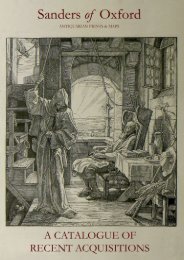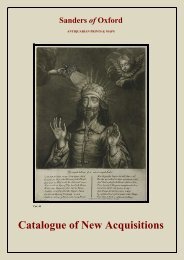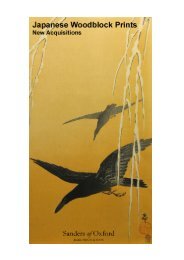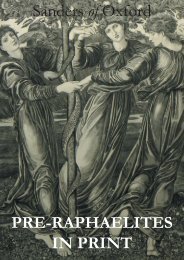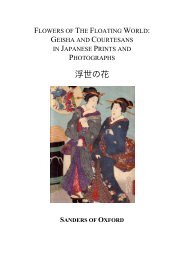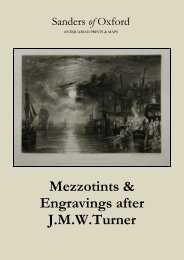Surimono catalogue FINAL WEB.pdf - Sanders of Oxford
Surimono catalogue FINAL WEB.pdf - Sanders of Oxford
Surimono catalogue FINAL WEB.pdf - Sanders of Oxford
Create successful ePaper yourself
Turn your PDF publications into a flip-book with our unique Google optimized e-Paper software.
Keisai Eisen (1790-1848)<br />
Keisai Eisen was the son <strong>of</strong> the colligrapher Ikeda Shigeharu. He was born in Edo and studied<br />
with a Kano painter, Hakkeisai, and then with Kikugawa Eizan. He specialised in pictures <strong>of</strong><br />
women, book illustrations and erotica. He designed a number <strong>of</strong> surimono in the late 1810s<br />
andlate 1820s.<br />
Hosoda Eishi (1756-1829)<br />
Hosoda Eishi was a samurai who studied with Kano Eisen in Sukenobu and became an <strong>of</strong>ficial<br />
painter at the court <strong>of</strong> the shogun in Edo. He was given the name Eishi, it the alleged, by the<br />
Tokugawa shogun Ieharu. In the mid 1780s he was supposed to have studied with an otherwise<br />
unknown ukiyo-e printmaker named Torii Bunryusai. Eishi designed his first woodblock prints<br />
around 1786. During the next decade he was very active as print designer, specializing in pictures<br />
<strong>of</strong> beautiful women. Around 1797 he retired from print design and devoted the rest <strong>of</strong> his life to<br />
painting.<br />
Kikukawa Eishin (fl. c. 1810s - 1820s)<br />
Kikukawa Eishin was a pupil <strong>of</strong> Kikukawa Eizan. He designed a few commerical and surimono<br />
prints.<br />
Kikugawa Eizan (1787-1868)<br />
Eizan was the most prolific, longest-lived and ultimately the best <strong>of</strong> the late followers <strong>of</strong> Utamaro,<br />
who attempted to carry on the master’s bijin style after his death in 1806. Along with Kikumaro,<br />
Tsukimaro and Utamaro II, Eizan has generally been dismissed by connoisseurs as a plagiarist<br />
<strong>of</strong> Utamaro’s late style, but his work developed, like that <strong>of</strong> most ukiyo-e artists, from a close<br />
identification with a leading master to a studied independence.Unlike the artists with whom he<br />
is <strong>of</strong>ten associated, Eizan was not an actual pupil <strong>of</strong> Kitagawa Utamaro, but studied originally<br />
with his father, Kikugawa Eiji, a Kano style painter and fan maker, and later with the Shijo artist<br />
Suzuki Nanrei and the Hokusai pupil Hokkei. He produced some remarkable triptychs and vertical<br />
diptychs, as well as a few surimono. He seems to have retired from printmaking in the late 1820s,<br />
though he did contribute illustrations for books even quite late in his life.<br />
Yashima Gakutei (c. 1786 - 1868)<br />
Schooled in Kokusai’s workshop under the tutelage <strong>of</strong> Hokkei, Gakutei, while principally involved<br />
in creating surimono, was a well known writer and kyôka poet. He was the illegitimate son <strong>of</strong><br />
an Edo samurai by the name <strong>of</strong> Hirata, who was in the service <strong>of</strong> the Bakufu. His mother’s<br />
subsequent marriage into the Yashima clan, however, gave him the art-name by which he is<br />
chiefly known. Although prolific, it was the delicate beauty and precise technical quality <strong>of</strong> his<br />
surimono, which distinguished him from other artists.<br />
Harukawa Goshichi (1776-1831)




